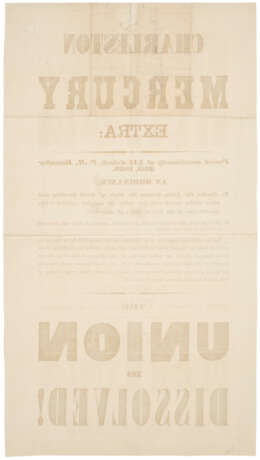ID 1362412
Lot 664 | The first secession ordinance
Estimate value
$ 10 000 – 15 000
[Charleston, 20 December 1860]
[CIVIL WAR]. Charleston Mercury Extra: Passed unanimously at 1.15 o'clock, P.M. December 20th 1860. An Ordinance to Dissolve the Union between the State of South Carolina and other States united with her under the compact entitled 'The Constitution of the United States of America.' … The Union is Dissolved! [Charleston, 20 December 1860].
The first printing of the first secession ordinance. South Carolina dissolves its bonds to the United States. The first state to bolt in the secession crisis. The "fire-eaters" in the South had made it clear: the election of the "Black republican" candidate Abraham Lincoln meant the end of the Union. One South Carolinian told a London journalist "Nothing on earth shall ever induce us to submit to any union with the brutal blackguards of the New England States!" (McPherson, Battle Cry, 234-35) In vain did Northerners and Southern Unionists try to point out the differences between Lincoln and the more radical abolitionists. Amidst a mood of revolutionary carnival, the Carolinians called a convention to consider secession. Outside bands marched, fireworks flared, and eager soldiers declared themselves neo-Minute Men. Only a single vote was taken, and the momentous ordinance was passed unanimously, 169 to 0. Within fifteen minutes this broadside announcement--probably set in type while the Convention met—was in circulation on the streets of Charleston. This began the avalanche. Within weeks six other states joined: Mississippi, Florida, Alabama, Georgia, Louisiana and Texas. The more cautious states in the upper South wavered, but the momentum towards disunion ultimately carried them into the Confederacy as well.
"EXTRA: Passed Unanimously at 1.115 o'clock, P.M., December 20th, 1860. An Ordinance to Dissolve the Union between the State of North Carolina and other States united with her under the compact entitled 'The Constitution of the United States of America.' We, the People of South Carolina, in Convention assembled, do declare and ordain, and it is hereby declared and ordained, That the Ordinance adopted by us in Convention, on the twenty-third day of May, in the year of our Lord one thousand seven hundred and eighty-eight, whereby the Constitution of the United States of America was ratified, and also, all Acts and parts of Acts of the General Assembly of this States, ratifying amendments of the said Constitution, are hereby repealed; and that the union now subsisting between South Carolina and other States, under the name of 'The United States of America,' is hereby dissolved." This began the avalanche. Within weeks six other states joined: Mississippi, Florida, Alabama, Georgia, Louisiana and Texas. The more cautious states in the upper South wavered, but the momentum towards disunion ultimately carried them into the Confederacy as well. Crandall 1888; Ray O. Hummell, Southeastern Broadsides Before 1877, no. 2434 (locating six copies); Sabin 87439. Provenance: A. T. White or Adrien Van Sinderen – by descent to the consignor.
Folio broadside. 582 x 322mm (Ink offsetting, several small tears repaired at upper margin, a few pinholes at fold intersections, former binding strip on verso, silked on verso.) Note in pencil on verso: "Bulletin of the Charleston Mercury on the passing of Act of Session by South Carolina." and "Save this Paper."
Sale room notice
Please note that this broadside is silked on the verso. The cataloguing has been updated accordingly.
| Category: | Book and magazine graphics, Services |
|---|---|
| Auction house category: | Books and manuscripts |
| Category: | Book and magazine graphics, Services |
|---|---|
| Auction house category: | Books and manuscripts |
| Address of auction |
CHRISTIE'S 20 Rockefeller Plaza 10020 New York USA | ||||||||||||||
|---|---|---|---|---|---|---|---|---|---|---|---|---|---|---|---|
| Preview |
| ||||||||||||||
| Phone | +1 212 636 2000 | ||||||||||||||
| Fax | +1 212 636 4930 | ||||||||||||||
| Conditions of purchase | Conditions of purchase | ||||||||||||||
| Shipping |
Postal service Courier service pickup by yourself | ||||||||||||||
| Payment methods |
Wire Transfer | ||||||||||||||
| Business hours | Business hours
|




